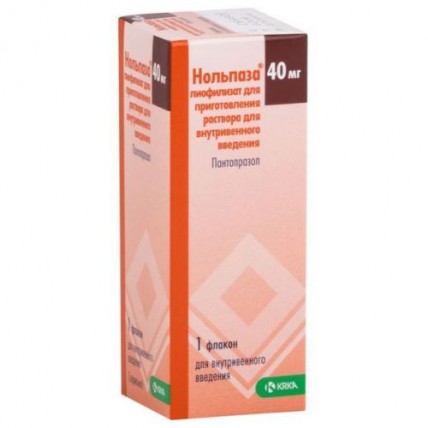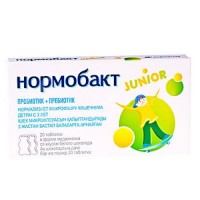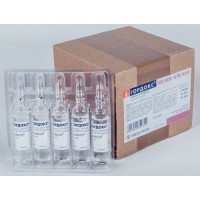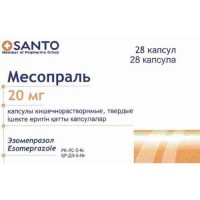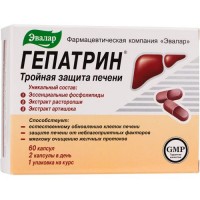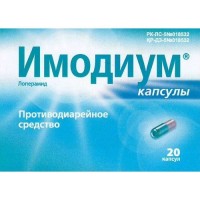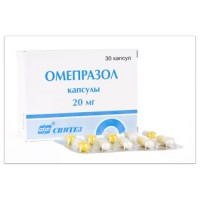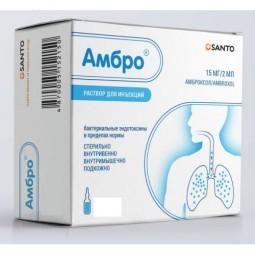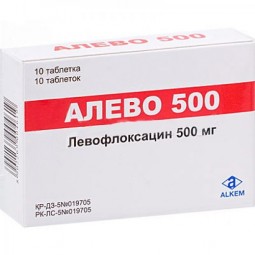Nolpaza 1's 40 mg powder for solution for injection
- $9.90
The instruction for medical use
of NOLPAZA® medicine
the Trade name
of Nolpaza®
the International unlicensed
name Pantoprazol Lekarstvennaya a form
Powder for preparation of solution for injections of 40 mg
Structure
One bottle contains
active agent - sodium of a pantoprazol of 42.3 mg is equivalent a pantoprazola of 40.0 mg,
excipients: Mannitolum for parenteral use, sodium citrate a dihydrate, 1 M hydroxide sodium solution, water for injections.
Description
of Liofilizovannaya homogeneous porous mass of white or almost white color.
The pharmacotherapeutic group
Antiulcerous means and the drugs used at a gastroesophageal reflux, inhibitors of a proton pomp
the Code of automatic telephone exchange A02BC02
the Pharmacological
Pharmacokinetics Pharmacokinetics properties does not change after single or repeated maintaining. In the range of doses of 10 mg - 80 mg the pharmacokinetics of a pantoprazol remains linear both after oral administration, and after intravenous administration.
Linking of a pantoprazol with proteins of blood plasma makes about 98%. Distribution volume - about 0.15 l/kg. Pantoprazol, is generally metabolized in a liver. The main way of metabolism demethylation by means of CYP2C19 with the subsequent conjugation with sulfate, other ways of metabolism include oxidation of CYP3A4.
Elimination half-life makes about 1 hour, and clearance - about 0.1 l/h/kg. Because of specific binding of a pantoprazol to proton pumps of covering cell the elimination half-life does not correspond with much longer duration of action (suppression of discharge of gastric acid). Renal removal represents the main way of discharge (about 80%) for metabolites of a pantoprazol, the others (20%) are allocated with excrements. The main metabolite which is found in blood plasma and in urine - desmetilpantoprazol which contacts sulfate. Elimination half-life of the main metabolite (about 1.5 hours) a little longer, than pantoprazola.
Patients with the weakened renal function do not need reduction of a dose of a pantoprazol (including the patients who are on dialysis).
Though the main metabolite has moderately delayed half-life period (2-3 hours), discharge occurs quickly, and thus, accumulation does not happen. Though for patients with cirrhosis (classes A and B) time of semi-removal increases till 7 - 9 o'clock and the AUC value (the area on a curve concentration time) increases to 5 - 7, the maximum plasma concentration increases a little (by 1.5 times, in comparison with healthy volunteers). Small increase in AUC and Cmax at elderly patients in comparison with young people also clinically is not important.
A pharmacodynamics
of Nolpaza®-the substituted benzimidazole which suppresses discharge of hydrochloric acid in a stomach a certain blockade of covering cells proton pumps.
Pantoprazol will be transformed to an active form in surrounding acidic environment in covering cells where he inhibits H+/K+ enzyme to ATFaz, that is on a final mode of formation of hydrochloric acid in a stomach. The inhibition depends on a dose and mentions the main and stimulated discharge of acid. At most of patients the termination of symptoms is reached within 2 weeks. As well as other inhibitors of a proton pomp and inhibitors of a receptor H2, therapy pantoprazoly are reduced by acidity in a stomach and, thus, increases gastrin in proportion to decrease in acidity. Increase in gastrin is reversible. As pantoprazol contacts the enzyme remote from a cellular receptor, substance can affect discharge of hydrochloric acid irrespective of stimulation with other substances (acetylcholine, a histamine, gastrin).
Action does not depend on an oral or intravenous route of administration of drug.
Indications
- the peptic ulcer of a stomach and duodenum including associated with Helicobacter pylori
- a gastroesophageal reflux disease (GERD) of the I-IV stage
- the erosive cankers of a stomach and duodenum connected with intake of non-steroidal anti-inflammatory drugs (NPVP)
- Zollingera-Ellison's syndrome or other states which are characterized by pathological gastric hypersecretion
- treatment and prevention of stressful ulcers and also their complications (bleeding, perforation, a penetration)
the Route of administration and dozypreparat has to be accepted on doctor's orders.
Intravenous administration of Nolpazy® is recommended only at inadequacy
of oral administration of medicine. Data of intravenous use of drug within no more than 7 days are available. Therefore as soon as there is possible an oral therapy, intravenous reception of Nolpazy® it is necessary to stop and begin oral administration of 40 mg of a pantoprazol in the form of tablets.
Ulcer of stomach and duodenum, a reflux esophagitis
the Recommended dose – one ampoule of Nolpazy® (40 mg) a day intravenously.
Eradikation Helicobacter pylori
In a combination with antibacterial therapy is appointed on 40 mg by 2 times a day within 7 days. Maintenance therapy – 20 – 40 mg of 1 times a day within 2-3 weeks.
The erosive cankers of a stomach and duodenum connected with reception of NPVP
On 40-80 mg a day. Course of treatment not less than 4 weeks.
Zollingera-Ellison's syndrome and other morbid hyper secretory conditions
At long-term treatment of patients with Zollingera-Ellison's syndrome and other morbid hyper secretory conditions, it is necessary to begin reception of Nolpazy® with a daily dose of 80 mg intravenously. After that the dosage can be increased or reduced if it is necessary, by results of the analysis of level of acidity of gastric juice. At a dosage it is higher than 80 mg daily, the dose has to be accepted twice a day. Temporary increase in a dosage of Nolpazy® higher than 160 mg is possible, but should not be applied longer, than it is necessary for the corresponding control of acidity. If fast control of acidity is required, the starting dose 2 x 80 mg of a pantoprazol is intravenously sufficient for acid discharge reduction in the target range (& lt, 10 mekv / h) within one hour at most of patients.
Liver failure:
For patients with a heavy liver failure it is not necessary to exceed a daily dose of a pantoprazol of 20 mg (a half of an ampoule of a pantoprazol of 40 mg.
The renal failure
Is not present need of additional adjustment of a dose for patients with the weakened renal function.
Elderly patients
Are not present need of adjustment of a dose for elderly patients
the Way of preparation of solution:
For preparation of solution for intravenous injections dry matter in a bottle is dissolved in 10 ml physiological (0.9%) chloride sodium solution. Ready solution can be used intravenously struyno or after mixing from 100 ml of normal saline solution of sodium of chloride (0.9%) or 5% of solution of glucose - intravenously by drop infusion, in 2-15 min. after preparation.
The prepared solution has to be used within 12 hours after preparation.
Side effects
Infrequently (less than 1 of 100):
- sleep disorders
- a headache, dizziness
- indigestions: nausea, vomiting, an abdominal distension, constipations, dryness
in a mouth, pain and discomfort
- increase in enzymes of a liver (transaminases, gamma glutaminetransferases)
- rashes, a dieback, sudden rash, an itching
- an asthenia, fatigue, discomfort
Seldom (less than 1 of 1000): - hypersensitivity (including anaphylactic reactions and
an acute anaphylaxis) - a lipidemia and increase in lipids (triglycerides, cholesterol),
change of weight - a depression (all complications) - sight disorders / out-of-focus sight - increase in bilirubin - an urticaria / angioedem
- an arthralgia, a myalgia
- a gynecomastia
- increase in body temperature, peripheral hypostasis
Is very rare (less than 1 of 10,000):
- thrombocytopenia, a leukopenia
- orientation disturbances (and all complications)
Isolated cases (their connection using drug is not established):
- a hyponatremia
- hallucinations: confusion of consciousness (especially at predisposed
patients and also a complication of the existing symptoms)
- damage of cells of a liver, a bilious attack, insufficiency of cells
of a liver
- Stephen-Johnson's syndrome, a Lyell's disease, a polymorphic erythema,
photosensitivity
- interstitial nephrite
of the Contraindication
- hypersensitivity to active agent,
the imidazole replaced benz-, or to any of excipients.
- the heavy renal failure
- simultaneous use with atazanaviry
Medicinal interactions
Impact of a pantoprazol on absorption of others medicinal produktoviz-for deep and long inhibition of discharge of gastric juice pantoprazol can reduce absorption of drugs which bioavailability depends from rn stomach environments, for example, some azolny fungicides, such as ketokonazol, intrakonazol, pozakonazol and other drugs, such as erlotinib. Drugs for treatment of HIV (atazanavir) the Concomitant use of an atazanavir and other drugs for treatment of HIV which absorption depends on PH value with inhibitors of a proton pomp, can lead to significant decrease in bioavailability of such drugs for treatment of HIV and can influence efficiency of these
drugs. Therefore, joint therapy of inhibitors of a proton pomp with atazanaviry is not recommended. (fenprokoumon or warfarin) At the patients accepting coumarin anticoagulants (for example, fenprokoumon or warfarin), control of a prothrombin time/INR (International Normalised Ratio) in an initiation of treatment, end is recommended to carry out coumarin anticoagulants or during irregular use of Nolpazy®.
Other interactions
Pantoprazol is extensively acquired in a liver through the system of enzyme of P450 cytochrome. The main way of metabolism - demethylation of CYP2C19, and other ways of metabolism include oxidation of CYP3A4.
Interaction researches with such drugs as carbamazepine, diazepam, glibenclamide, nifedipine and the oral contraceptives containing levonorgestrel and acetenyl oestradiol which have the same way of metabolism showed lack of clinically significant interactions.
Pantoprazol does not influence active agents, metabolized by means of CYP1A2 (such as caffeine, theophylline), CYP2C9 (such as piroxicam, diclofenac, Naproxenum), CYP2D6 (such as metoprolol), CYP2E1
(such as ethanol) or does not participate in digoxin absorption, connected with
a p-glycoprotein.
There were no interactions with the means neutralizing acid which were accepted at the same time.
Researches of interaction of joint reception of a pantoprazol with the corresponding antibiotics (klaritromitsin, metronidazole, amoxicillin)
showed lack of clinically significant interactions.
Special instructions
in the presence of disturbing symptoms
in the presence of any disturbing symptom (for example, significant inadvertent loss of weight, the current vomiting, a dysphagy, vomiting blood, anemia or a melena), at existence or suspicion of stomach ulcer, the malignant tumor as reception can facilitate symptoms has to be excluded and delay diagnosis. If symptoms remain despite the corresponding treatment, it is necessary to continue further researches.
A liver failure
At patients with a heavy liver failure during treatment it is necessary to control the level of liver enzymes. In case of increase in enzymes of a liver, reception of a pantoprazol intravenously should be stopped.
Joint treatment with atazanaviry
is not recommended joint reception of an atazanavir with inhibitors of a proton pomp. If the combination of an atazanavir with inhibitor of a proton pomp is recognized as inevitable, stringent clinical control (for example, viral load) in a combination with increase in a dose of an atazanavir up to 400 mg from 100 mg of a ritonavir is recommended. The daily dose should not be higher than 20 mg.
The gastrointestinal infections caused by bacteria
of Nolpaza® as all inhibitors of the proton pump (IPP), the quantity of bacteria increases which are usually existing in upper digestive tract. Reception of a pantoprazol can increase several risk of the gastrointestinal infections caused by bacteria (for example, Salmonella and Campilobacter).
Sodium
This medicine contains less than 1 mmol (23 mg) of sodium in each dose, that is actually 'is free from sodium'.
Use in pediatrics
of Data on use of the drug Nolpaza®u of children is younger than 12 years is not available.
Pregnancy and the period of a lactation
Are not present any adequate data on use of Nolpazy® at
pregnancy. Нольпаза® it should not be applied during pregnancy
if there is no need.
Нольпаза® it is allocated in breast milk. The lactation for drug treatment is stopped.
Features of influence of medicine on ability to run the vehicle or potentially dangerous mechanisms
the Question of a possibility of occupations potentially dangerous types of activity requiring special attention and speed of psychomotor reactions should be solved only after assessment of individual reaction of the patient to drug (in connection with a possibility of development of dizziness and
visual disturbance).
Overdose
Data on overdose are absent.
The form of release and packing
On 40 mg place in bottles of colourless glass. Bottles cork up from chlorbutyl of gray color for liofilizovanny drugs and an aluminum cover with flip-off of yellow color.
On 1, 5, 10 or 20 bottles together with the instruction for medical use in the state and Russian languages place in a cardboard box.
To Store storage conditions in original packing at a temperature not over 25 ºС, in the place protected from light.
To store in inaccessible for children in the place!
Prescription status
According to the prescription
the Period of storage
2 years
Producer Laboratories Alcala Farma, S.L., Spain
for KRK, of, Are new the Place, Slovenia
the Name and the country of the owner of the registration certificate
of KRK, of, the Place, Slovenia
the Address of the organization accepting in the territory of the Republic of Kazakhstan claims from consumers on quality of products (goods) Representation KRKA, tovarna zdravil, d.d., Novo mesto in RKRK, 050059, Almaty, Al-Farabi Ave., 5/1 Is new, body 1B, 2 etazhtet. 8 (727) 311-08-09факс 8 (727) 311-08-12www.krka.si
to Develop
of NOLPAZA® medicine
the Trade name
of Nolpaza®
the International unlicensed
name Pantoprazol Lekarstvennaya a form
Powder for preparation of solution for injections of 40 mg
Structure
One bottle contains
active agent - sodium of a pantoprazol of 42.3 mg is equivalent a pantoprazola of 40.0 mg,
excipients: Mannitolum for parenteral use, sodium citrate a dihydrate, 1 M hydroxide sodium solution, water for injections.
Description
of Liofilizovannaya homogeneous porous mass of white or almost white color.
The pharmacotherapeutic group
Antiulcerous means and the drugs used at a gastroesophageal reflux, inhibitors of a proton pomp
the Code of automatic telephone exchange A02BC02
the Pharmacological
Pharmacokinetics Pharmacokinetics properties does not change after single or repeated maintaining. In the range of doses of 10 mg - 80 mg the pharmacokinetics of a pantoprazol remains linear both after oral administration, and after intravenous administration.
Linking of a pantoprazol with proteins of blood plasma makes about 98%. Distribution volume - about 0.15 l/kg. Pantoprazol, is generally metabolized in a liver. The main way of metabolism demethylation by means of CYP2C19 with the subsequent conjugation with sulfate, other ways of metabolism include oxidation of CYP3A4.
Elimination half-life makes about 1 hour, and clearance - about 0.1 l/h/kg. Because of specific binding of a pantoprazol to proton pumps of covering cell the elimination half-life does not correspond with much longer duration of action (suppression of discharge of gastric acid). Renal removal represents the main way of discharge (about 80%) for metabolites of a pantoprazol, the others (20%) are allocated with excrements. The main metabolite which is found in blood plasma and in urine - desmetilpantoprazol which contacts sulfate. Elimination half-life of the main metabolite (about 1.5 hours) a little longer, than pantoprazola.
Patients with the weakened renal function do not need reduction of a dose of a pantoprazol (including the patients who are on dialysis).
Though the main metabolite has moderately delayed half-life period (2-3 hours), discharge occurs quickly, and thus, accumulation does not happen. Though for patients with cirrhosis (classes A and B) time of semi-removal increases till 7 - 9 o'clock and the AUC value (the area on a curve concentration time) increases to 5 - 7, the maximum plasma concentration increases a little (by 1.5 times, in comparison with healthy volunteers). Small increase in AUC and Cmax at elderly patients in comparison with young people also clinically is not important.
A pharmacodynamics
of Nolpaza®-the substituted benzimidazole which suppresses discharge of hydrochloric acid in a stomach a certain blockade of covering cells proton pumps.
Pantoprazol will be transformed to an active form in surrounding acidic environment in covering cells where he inhibits H+/K+ enzyme to ATFaz, that is on a final mode of formation of hydrochloric acid in a stomach. The inhibition depends on a dose and mentions the main and stimulated discharge of acid. At most of patients the termination of symptoms is reached within 2 weeks. As well as other inhibitors of a proton pomp and inhibitors of a receptor H2, therapy pantoprazoly are reduced by acidity in a stomach and, thus, increases gastrin in proportion to decrease in acidity. Increase in gastrin is reversible. As pantoprazol contacts the enzyme remote from a cellular receptor, substance can affect discharge of hydrochloric acid irrespective of stimulation with other substances (acetylcholine, a histamine, gastrin).
Action does not depend on an oral or intravenous route of administration of drug.
Indications
- the peptic ulcer of a stomach and duodenum including associated with Helicobacter pylori
- a gastroesophageal reflux disease (GERD) of the I-IV stage
- the erosive cankers of a stomach and duodenum connected with intake of non-steroidal anti-inflammatory drugs (NPVP)
- Zollingera-Ellison's syndrome or other states which are characterized by pathological gastric hypersecretion
- treatment and prevention of stressful ulcers and also their complications (bleeding, perforation, a penetration)
the Route of administration and dozypreparat has to be accepted on doctor's orders.
Intravenous administration of Nolpazy® is recommended only at inadequacy
of oral administration of medicine. Data of intravenous use of drug within no more than 7 days are available. Therefore as soon as there is possible an oral therapy, intravenous reception of Nolpazy® it is necessary to stop and begin oral administration of 40 mg of a pantoprazol in the form of tablets.
Ulcer of stomach and duodenum, a reflux esophagitis
the Recommended dose – one ampoule of Nolpazy® (40 mg) a day intravenously.
Eradikation Helicobacter pylori
In a combination with antibacterial therapy is appointed on 40 mg by 2 times a day within 7 days. Maintenance therapy – 20 – 40 mg of 1 times a day within 2-3 weeks.
The erosive cankers of a stomach and duodenum connected with reception of NPVP
On 40-80 mg a day. Course of treatment not less than 4 weeks.
Zollingera-Ellison's syndrome and other morbid hyper secretory conditions
At long-term treatment of patients with Zollingera-Ellison's syndrome and other morbid hyper secretory conditions, it is necessary to begin reception of Nolpazy® with a daily dose of 80 mg intravenously. After that the dosage can be increased or reduced if it is necessary, by results of the analysis of level of acidity of gastric juice. At a dosage it is higher than 80 mg daily, the dose has to be accepted twice a day. Temporary increase in a dosage of Nolpazy® higher than 160 mg is possible, but should not be applied longer, than it is necessary for the corresponding control of acidity. If fast control of acidity is required, the starting dose 2 x 80 mg of a pantoprazol is intravenously sufficient for acid discharge reduction in the target range (& lt, 10 mekv / h) within one hour at most of patients.
Liver failure:
For patients with a heavy liver failure it is not necessary to exceed a daily dose of a pantoprazol of 20 mg (a half of an ampoule of a pantoprazol of 40 mg.
The renal failure
Is not present need of additional adjustment of a dose for patients with the weakened renal function.
Elderly patients
Are not present need of adjustment of a dose for elderly patients
the Way of preparation of solution:
For preparation of solution for intravenous injections dry matter in a bottle is dissolved in 10 ml physiological (0.9%) chloride sodium solution. Ready solution can be used intravenously struyno or after mixing from 100 ml of normal saline solution of sodium of chloride (0.9%) or 5% of solution of glucose - intravenously by drop infusion, in 2-15 min. after preparation.
The prepared solution has to be used within 12 hours after preparation.
Side effects
Infrequently (less than 1 of 100):
- sleep disorders
- a headache, dizziness
- indigestions: nausea, vomiting, an abdominal distension, constipations, dryness
in a mouth, pain and discomfort
- increase in enzymes of a liver (transaminases, gamma glutaminetransferases)
- rashes, a dieback, sudden rash, an itching
- an asthenia, fatigue, discomfort
Seldom (less than 1 of 1000): - hypersensitivity (including anaphylactic reactions and
an acute anaphylaxis) - a lipidemia and increase in lipids (triglycerides, cholesterol),
change of weight - a depression (all complications) - sight disorders / out-of-focus sight - increase in bilirubin - an urticaria / angioedem
- an arthralgia, a myalgia
- a gynecomastia
- increase in body temperature, peripheral hypostasis
Is very rare (less than 1 of 10,000):
- thrombocytopenia, a leukopenia
- orientation disturbances (and all complications)
Isolated cases (their connection using drug is not established):
- a hyponatremia
- hallucinations: confusion of consciousness (especially at predisposed
patients and also a complication of the existing symptoms)
- damage of cells of a liver, a bilious attack, insufficiency of cells
of a liver
- Stephen-Johnson's syndrome, a Lyell's disease, a polymorphic erythema,
photosensitivity
- interstitial nephrite
of the Contraindication
- hypersensitivity to active agent,
the imidazole replaced benz-, or to any of excipients.
- the heavy renal failure
- simultaneous use with atazanaviry
Medicinal interactions
Impact of a pantoprazol on absorption of others medicinal produktoviz-for deep and long inhibition of discharge of gastric juice pantoprazol can reduce absorption of drugs which bioavailability depends from rn stomach environments, for example, some azolny fungicides, such as ketokonazol, intrakonazol, pozakonazol and other drugs, such as erlotinib. Drugs for treatment of HIV (atazanavir) the Concomitant use of an atazanavir and other drugs for treatment of HIV which absorption depends on PH value with inhibitors of a proton pomp, can lead to significant decrease in bioavailability of such drugs for treatment of HIV and can influence efficiency of these
drugs. Therefore, joint therapy of inhibitors of a proton pomp with atazanaviry is not recommended. (fenprokoumon or warfarin) At the patients accepting coumarin anticoagulants (for example, fenprokoumon or warfarin), control of a prothrombin time/INR (International Normalised Ratio) in an initiation of treatment, end is recommended to carry out coumarin anticoagulants or during irregular use of Nolpazy®.
Other interactions
Pantoprazol is extensively acquired in a liver through the system of enzyme of P450 cytochrome. The main way of metabolism - demethylation of CYP2C19, and other ways of metabolism include oxidation of CYP3A4.
Interaction researches with such drugs as carbamazepine, diazepam, glibenclamide, nifedipine and the oral contraceptives containing levonorgestrel and acetenyl oestradiol which have the same way of metabolism showed lack of clinically significant interactions.
Pantoprazol does not influence active agents, metabolized by means of CYP1A2 (such as caffeine, theophylline), CYP2C9 (such as piroxicam, diclofenac, Naproxenum), CYP2D6 (such as metoprolol), CYP2E1
(such as ethanol) or does not participate in digoxin absorption, connected with
a p-glycoprotein.
There were no interactions with the means neutralizing acid which were accepted at the same time.
Researches of interaction of joint reception of a pantoprazol with the corresponding antibiotics (klaritromitsin, metronidazole, amoxicillin)
showed lack of clinically significant interactions.
Special instructions
in the presence of disturbing symptoms
in the presence of any disturbing symptom (for example, significant inadvertent loss of weight, the current vomiting, a dysphagy, vomiting blood, anemia or a melena), at existence or suspicion of stomach ulcer, the malignant tumor as reception can facilitate symptoms has to be excluded and delay diagnosis. If symptoms remain despite the corresponding treatment, it is necessary to continue further researches.
A liver failure
At patients with a heavy liver failure during treatment it is necessary to control the level of liver enzymes. In case of increase in enzymes of a liver, reception of a pantoprazol intravenously should be stopped.
Joint treatment with atazanaviry
is not recommended joint reception of an atazanavir with inhibitors of a proton pomp. If the combination of an atazanavir with inhibitor of a proton pomp is recognized as inevitable, stringent clinical control (for example, viral load) in a combination with increase in a dose of an atazanavir up to 400 mg from 100 mg of a ritonavir is recommended. The daily dose should not be higher than 20 mg.
The gastrointestinal infections caused by bacteria
of Nolpaza® as all inhibitors of the proton pump (IPP), the quantity of bacteria increases which are usually existing in upper digestive tract. Reception of a pantoprazol can increase several risk of the gastrointestinal infections caused by bacteria (for example, Salmonella and Campilobacter).
Sodium
This medicine contains less than 1 mmol (23 mg) of sodium in each dose, that is actually 'is free from sodium'.
Use in pediatrics
of Data on use of the drug Nolpaza®u of children is younger than 12 years is not available.
Pregnancy and the period of a lactation
Are not present any adequate data on use of Nolpazy® at
pregnancy. Нольпаза® it should not be applied during pregnancy
if there is no need.
Нольпаза® it is allocated in breast milk. The lactation for drug treatment is stopped.
Features of influence of medicine on ability to run the vehicle or potentially dangerous mechanisms
the Question of a possibility of occupations potentially dangerous types of activity requiring special attention and speed of psychomotor reactions should be solved only after assessment of individual reaction of the patient to drug (in connection with a possibility of development of dizziness and
visual disturbance).
Overdose
Data on overdose are absent.
The form of release and packing
On 40 mg place in bottles of colourless glass. Bottles cork up from chlorbutyl of gray color for liofilizovanny drugs and an aluminum cover with flip-off of yellow color.
On 1, 5, 10 or 20 bottles together with the instruction for medical use in the state and Russian languages place in a cardboard box.
To Store storage conditions in original packing at a temperature not over 25 ºС, in the place protected from light.
To store in inaccessible for children in the place!
Prescription status
According to the prescription
the Period of storage
2 years
Producer Laboratories Alcala Farma, S.L., Spain
for KRK, of, Are new the Place, Slovenia
the Name and the country of the owner of the registration certificate
of KRK, of, the Place, Slovenia
the Address of the organization accepting in the territory of the Republic of Kazakhstan claims from consumers on quality of products (goods) Representation KRKA, tovarna zdravil, d.d., Novo mesto in RKRK, 050059, Almaty, Al-Farabi Ave., 5/1 Is new, body 1B, 2 etazhtet. 8 (727) 311-08-09факс 8 (727) 311-08-12www.krka.si
to Develop
